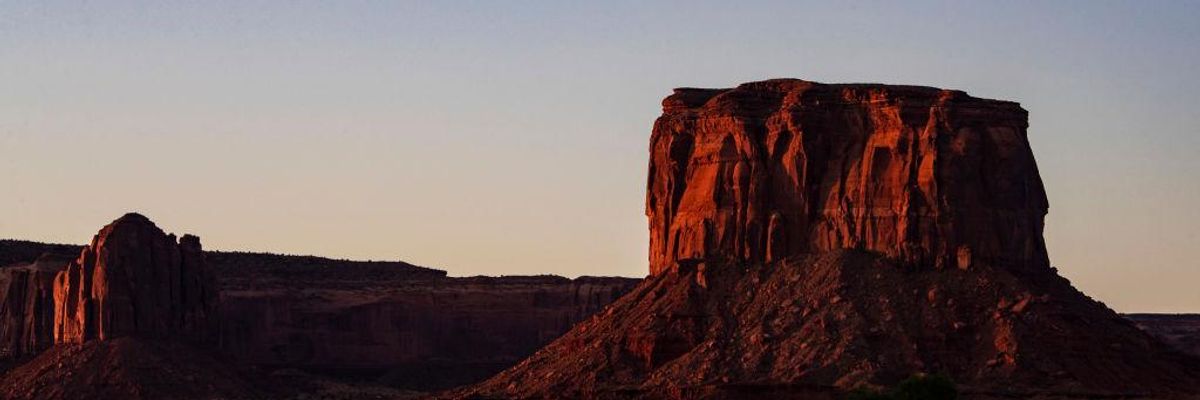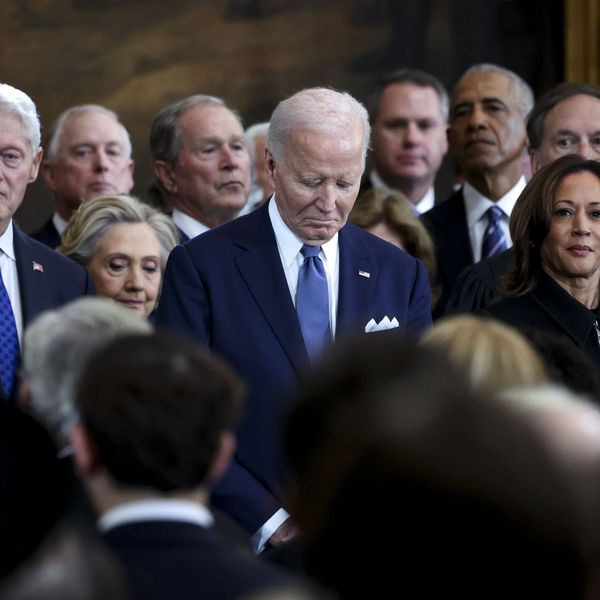
Dawn breaks over homes and sandstone formations near the Monument Valley Navajo Tribal Park, which is closed until further notice on the Navajo Reservation on Sunday, May 24, 2020 in Oljato-Monument Valley, AZ. (Brian van der Brug / Los Angeles Times via Getty Images)
In Indian Country, It's Not the Weather, It's the Racism That's Leaving Thousands in the Dark
How do we explain the fact that of the 55,000 homes in the Navajo Nation, about 15,000 don’t have electricity—now, or at any time?
Around 30,000 homes in Texas still have no power, and millions of Texans remain under a boil-water mandate days after a deadly winter storm wiped out that state's weak water and energy systems.
In Texas, president Biden has officially declared this scenario a disaster, and the state's failed leadership stands squarely under attack.
Media coverage has been empathetic. Audiences across the country have heard the heart-wrenching stories of people like eleven-year-old Cristian Pavon, who froze in his family's mobile home, or Loan Le who died with her three grandchildren in a home fire in Sugarland.
They're turning to renewable energy to transition not just to cleaner power, but also to become self-sufficient from greedy utility non-providers.
But if deaths from lack of care, cold, and a lack of access to electricity are deemed disasters in Texas, how do we explain the fact that of the 55,000 homes in the Navajo Nation, about 15,000 don't have electricity -- now, or at any time?
If the fragility of the grid is an emergency requiring urgent attention at all levels of government in Texas, how do we live with the decades-long reality that tens of thousands of families in Indian Country have had no electricity and limited cell and broadband access not for a day or a week, but for years already?
Even as those needs got worse during the Covid-19 pandemic, there was no outcry about families unable to stay home because they couldn't refrigerate food or kids struggling to learn remotely with no light for reading and no wifi for miles on the reservation.
In Indian country, it's not the weather that's the problem, it's the racism and the disregard.
The flip side of the indigenous story is that fed-up Native Americans have been helping themselves and each other. And they're turning to renewable energy to transition not just to cleaner power, but also to become self-sufficient from greedy utility non-providers. Seeking energy independence, groups like Native Renewables have been advancing off-grid solar solutions to cut-off Navajo people, whether local government is supporting them or not.
And one of the leaders of this transition, Wahleah Johns, has just joined the Biden administration where she'll be heading up the Office of Indian Energy and sharing her experiences with the Navajo Nation and strategies for energy independence with thousands of other Indigenous communities.
Who knows, maybe she'd be willing to talk to some fed-up Texans.
You can see my interviews with up-and-coming indigenous leaders, and see them in action in local government, philanthropy, and self-organizing, this week on The Laura Flanders Show. Watch it on YouTube or on PBS stations across the country. Click here for listings.
An Urgent Message From Our Co-Founder
Dear Common Dreams reader, The U.S. is on a fast track to authoritarianism like nothing I've ever seen. Meanwhile, corporate news outlets are utterly capitulating to Trump, twisting their coverage to avoid drawing his ire while lining up to stuff cash in his pockets. That's why I believe that Common Dreams is doing the best and most consequential reporting that we've ever done. Our small but mighty team is a progressive reporting powerhouse, covering the news every day that the corporate media never will. Our mission has always been simple: To inform. To inspire. And to ignite change for the common good. Now here's the key piece that I want all our readers to understand: None of this would be possible without your financial support. That's not just some fundraising cliche. It's the absolute and literal truth. We don't accept corporate advertising and never will. We don't have a paywall because we don't think people should be blocked from critical news based on their ability to pay. Everything we do is funded by the donations of readers like you. Will you donate now to help power the nonprofit, independent reporting of Common Dreams? Thank you for being a vital member of our community. Together, we can keep independent journalism alive when it’s needed most. - Craig Brown, Co-founder |
Around 30,000 homes in Texas still have no power, and millions of Texans remain under a boil-water mandate days after a deadly winter storm wiped out that state's weak water and energy systems.
In Texas, president Biden has officially declared this scenario a disaster, and the state's failed leadership stands squarely under attack.
Media coverage has been empathetic. Audiences across the country have heard the heart-wrenching stories of people like eleven-year-old Cristian Pavon, who froze in his family's mobile home, or Loan Le who died with her three grandchildren in a home fire in Sugarland.
They're turning to renewable energy to transition not just to cleaner power, but also to become self-sufficient from greedy utility non-providers.
But if deaths from lack of care, cold, and a lack of access to electricity are deemed disasters in Texas, how do we explain the fact that of the 55,000 homes in the Navajo Nation, about 15,000 don't have electricity -- now, or at any time?
If the fragility of the grid is an emergency requiring urgent attention at all levels of government in Texas, how do we live with the decades-long reality that tens of thousands of families in Indian Country have had no electricity and limited cell and broadband access not for a day or a week, but for years already?
Even as those needs got worse during the Covid-19 pandemic, there was no outcry about families unable to stay home because they couldn't refrigerate food or kids struggling to learn remotely with no light for reading and no wifi for miles on the reservation.
In Indian country, it's not the weather that's the problem, it's the racism and the disregard.
The flip side of the indigenous story is that fed-up Native Americans have been helping themselves and each other. And they're turning to renewable energy to transition not just to cleaner power, but also to become self-sufficient from greedy utility non-providers. Seeking energy independence, groups like Native Renewables have been advancing off-grid solar solutions to cut-off Navajo people, whether local government is supporting them or not.
And one of the leaders of this transition, Wahleah Johns, has just joined the Biden administration where she'll be heading up the Office of Indian Energy and sharing her experiences with the Navajo Nation and strategies for energy independence with thousands of other Indigenous communities.
Who knows, maybe she'd be willing to talk to some fed-up Texans.
You can see my interviews with up-and-coming indigenous leaders, and see them in action in local government, philanthropy, and self-organizing, this week on The Laura Flanders Show. Watch it on YouTube or on PBS stations across the country. Click here for listings.
Around 30,000 homes in Texas still have no power, and millions of Texans remain under a boil-water mandate days after a deadly winter storm wiped out that state's weak water and energy systems.
In Texas, president Biden has officially declared this scenario a disaster, and the state's failed leadership stands squarely under attack.
Media coverage has been empathetic. Audiences across the country have heard the heart-wrenching stories of people like eleven-year-old Cristian Pavon, who froze in his family's mobile home, or Loan Le who died with her three grandchildren in a home fire in Sugarland.
They're turning to renewable energy to transition not just to cleaner power, but also to become self-sufficient from greedy utility non-providers.
But if deaths from lack of care, cold, and a lack of access to electricity are deemed disasters in Texas, how do we explain the fact that of the 55,000 homes in the Navajo Nation, about 15,000 don't have electricity -- now, or at any time?
If the fragility of the grid is an emergency requiring urgent attention at all levels of government in Texas, how do we live with the decades-long reality that tens of thousands of families in Indian Country have had no electricity and limited cell and broadband access not for a day or a week, but for years already?
Even as those needs got worse during the Covid-19 pandemic, there was no outcry about families unable to stay home because they couldn't refrigerate food or kids struggling to learn remotely with no light for reading and no wifi for miles on the reservation.
In Indian country, it's not the weather that's the problem, it's the racism and the disregard.
The flip side of the indigenous story is that fed-up Native Americans have been helping themselves and each other. And they're turning to renewable energy to transition not just to cleaner power, but also to become self-sufficient from greedy utility non-providers. Seeking energy independence, groups like Native Renewables have been advancing off-grid solar solutions to cut-off Navajo people, whether local government is supporting them or not.
And one of the leaders of this transition, Wahleah Johns, has just joined the Biden administration where she'll be heading up the Office of Indian Energy and sharing her experiences with the Navajo Nation and strategies for energy independence with thousands of other Indigenous communities.
Who knows, maybe she'd be willing to talk to some fed-up Texans.
You can see my interviews with up-and-coming indigenous leaders, and see them in action in local government, philanthropy, and self-organizing, this week on The Laura Flanders Show. Watch it on YouTube or on PBS stations across the country. Click here for listings.

